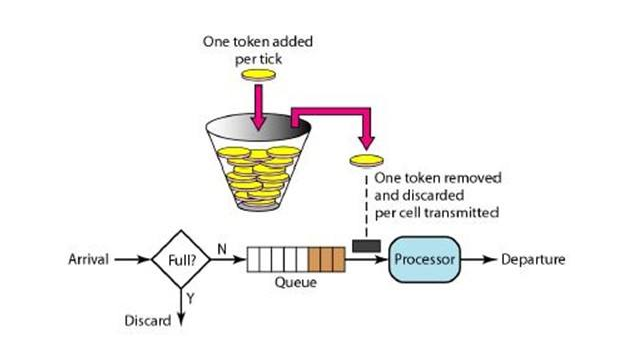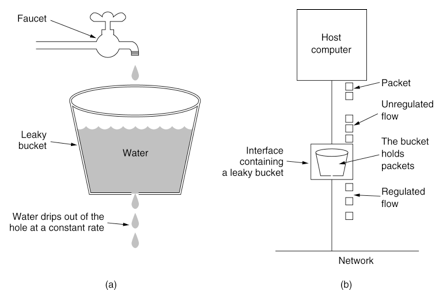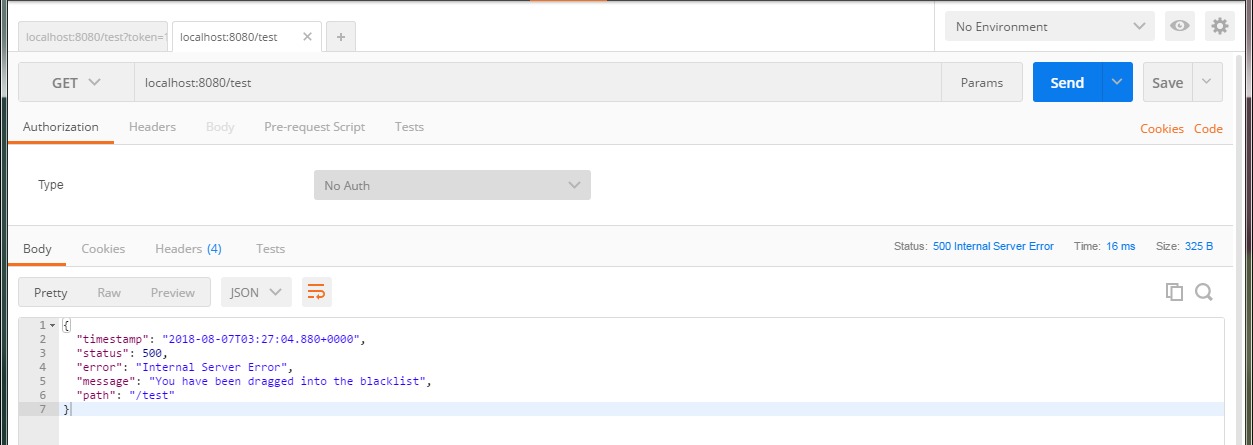您好,登錄后才能下訂單哦!
您好,登錄后才能下訂單哦!
這期內容當中小編將會給大家帶來有關Springboot中怎么實現分布式限流,文章內容豐富且以專業的角度為大家分析和敘述,閱讀完這篇文章希望大家可以有所收獲。
限流算法介紹
a、令牌桶算法
令牌桶算法的原理是系統會以一個恒定的速度往桶里放入令牌,而如果請求需要被處理,則需要先從桶里獲取一個令牌,當桶里沒有令牌可取時,則拒絕服務。 當桶滿時,新添加的令牌被丟棄或拒絕。

b、漏桶算法
其主要目的是控制數據注入到網絡的速率,平滑網絡上的突發流量,數據可以以任意速度流入到漏桶中。漏桶算法提供了一種機制,通過它,突發流量可以被整形以便為網絡提供一個穩定的流量。 漏桶可以看作是一個帶有常量服務時間的單服務器隊列,如果漏桶為空,則不需要流出水滴,如果漏桶(包緩存)溢出,那么水滴會被溢出丟棄

c、計算器限流
計數器限流算法是比較常用一種的限流方案也是最為粗暴直接的,主要用來限制總并發數,比如數據庫連接池大小、線程池大小、接口訪問并發數等都是使用計數器算法
如:使用AomicInteger來進行統計當前正在并發執行的次數,如果超過域值就直接拒絕請求,提示系統繁忙
限流具體代碼實踐
a、導入依賴
<dependencies> <dependency> <groupId>org.springframework.boot</groupId> <artifactId>spring-boot-starter-aop</artifactId> </dependency> <dependency> <groupId>org.springframework.boot</groupId> <artifactId>spring-boot-starter-web</artifactId> </dependency> <dependency> <groupId>org.springframework.boot</groupId> <artifactId>spring-boot-starter-data-redis</artifactId> </dependency> <dependency> <groupId>com.google.guava</groupId> <artifactId>guava</artifactId> <version>21.0</version> </dependency> <dependency> <groupId>org.apache.commons</groupId> <artifactId>commons-lang3</artifactId> </dependency> <dependency> <groupId>org.springframework.boot</groupId> <artifactId>spring-boot-starter-test</artifactId> </dependency> </dependencies>
b、屬性配置
在application.properites資源文件中添加redis相關的配置項
spring.redis.host=192.168.68.110 spring.redis.port=6379 spring.redis.password=123456
默認情況下spring-boot-data-redis為我們提供了StringRedisTemplate但是滿足不了其它類型的轉換,所以還是得自己去定義其它類型的模板
import org.springframework.context.annotation.Bean;
import org.springframework.context.annotation.Configuration;
import org.springframework.data.redis.connection.lettuce.LettuceConnectionFactory;
import org.springframework.data.redis.core.RedisTemplate;
import org.springframework.data.redis.serializer.GenericJackson2JsonRedisSerializer;
import org.springframework.data.redis.serializer.StringRedisSerializer;
import java.io.Serializable;
/**
* redis配置
*/
@Configuration
public class RedisConfig {
@Bean
public RedisTemplate<String, Serializable> limitRedisTemplate(LettuceConnectionFactory redisConnectionFactory) {
RedisTemplate<String, Serializable> template = new RedisTemplate<>();
template.setKeySerializer(new StringRedisSerializer());
template.setValueSerializer(new GenericJackson2JsonRedisSerializer());
template.setConnectionFactory(redisConnectionFactory);
return template;
}
}d、Limit 注解
具體代碼如下
import com.carry.enums.LimitType;
import java.lang.annotation.Documented;
import java.lang.annotation.ElementType;
import java.lang.annotation.Inherited;
import java.lang.annotation.Retention;
import java.lang.annotation.RetentionPolicy;
import java.lang.annotation.Target;
/**
* 限流
*/
@Target({ElementType.METHOD, ElementType.TYPE})
@Retention(RetentionPolicy.RUNTIME)
@Inherited
@Documented
public @interface Limit {
/**
* 資源的名字
*
* @return String
*/
String name() default "";
/**
* 資源的key
*
* @return String
*/
String key() default "";
/**
* Key的prefix
*
* @return String
*/
String prefix() default "";
/**
* 給定的時間段
* 單位秒
*
* @return int
*/
int period();
/**
* 最多的訪問限制次數
*
* @return int
*/
int count();
/**
* 類型
*
* @return LimitType
*/
LimitType limitType() default LimitType.CUSTOMER;
}package com.carry.enums;
public enum LimitType {
/**
* 自定義key
*/
CUSTOMER,
/**
* 根據請求者IP
*/
IP;
}e、Limit 攔截器(AOP)
我們可以通過編寫 Lua 腳本實現自己的API,核心就是調用execute方法傳入我們的 Lua 腳本內容,然后通過返回值判斷是否超出我們預期的范圍,超出則給出錯誤提示。
import com.carry.annotation.Limit;
import com.carry.enums.LimitType;
import com.google.common.collect.ImmutableList;
import org.apache.commons.lang3.StringUtils;
import org.aspectj.lang.ProceedingJoinPoint;
import org.aspectj.lang.annotation.Around;
import org.aspectj.lang.annotation.Aspect;
import org.aspectj.lang.reflect.MethodSignature;
import org.slf4j.Logger;
import org.slf4j.LoggerFactory;
import org.springframework.beans.factory.annotation.Autowired;
import org.springframework.context.annotation.Configuration;
import org.springframework.data.redis.core.RedisTemplate;
import org.springframework.data.redis.core.script.DefaultRedisScript;
import org.springframework.data.redis.core.script.RedisScript;
import org.springframework.web.context.request.RequestContextHolder;
import org.springframework.web.context.request.ServletRequestAttributes;
import javax.servlet.http.HttpServletRequest;
import java.io.Serializable;
import java.lang.reflect.Method;
@Aspect
@Configuration
public class LimitInterceptor {
private static final Logger logger = LoggerFactory.getLogger(LimitInterceptor.class);
private final RedisTemplate<String, Serializable> limitRedisTemplate;
@Autowired
public LimitInterceptor(RedisTemplate<String, Serializable> limitRedisTemplate) {
this.limitRedisTemplate = limitRedisTemplate;
}
@Around("execution(public * *(..)) && @annotation(com.carry.annotation.Limit)")
public Object interceptor(ProceedingJoinPoint pjp) {
MethodSignature signature = (MethodSignature) pjp.getSignature();
Method method = signature.getMethod();
Limit limitAnnotation = method.getAnnotation(Limit.class);
LimitType limitType = limitAnnotation.limitType();
String name = limitAnnotation.name();
String key;
int limitPeriod = limitAnnotation.period();
int limitCount = limitAnnotation.count();
switch (limitType) {
case IP:
key = getIpAddress();
break;
case CUSTOMER:
key = limitAnnotation.key();
break;
default:
key = StringUtils.upperCase(method.getName());
}
ImmutableList<String> keys = ImmutableList.of(StringUtils.join(limitAnnotation.prefix(), key));
try {
String luaScript = buildLuaScript();
RedisScript<Number> redisScript = new DefaultRedisScript<>(luaScript, Number.class);
Number count = limitRedisTemplate.execute(redisScript, keys, limitCount, limitPeriod);
logger.info("Access try count is {} for name={} and key = {}", count, name, key);
if (count != null && count.intValue() <= limitCount) {
return pjp.proceed();
} else {
throw new RuntimeException("You have been dragged into the blacklist");
}
} catch (Throwable e) {
if (e instanceof RuntimeException) {
throw new RuntimeException(e.getLocalizedMessage());
}
throw new RuntimeException("server exception");
}
}
/**
* 限流 腳本
*
* @return lua腳本
*/
public String buildLuaScript() {
StringBuilder lua = new StringBuilder();
lua.append("local c");
lua.append("\nc = redis.call('get',KEYS[1])");
// 調用不超過最大值,則直接返回
lua.append("\nif c and tonumber(c) > tonumber(ARGV[1]) then");
lua.append("\nreturn c;");
lua.append("\nend");
// 執行計算器自加
lua.append("\nc = redis.call('incr',KEYS[1])");
lua.append("\nif tonumber(c) == 1 then");
// 從第一次調用開始限流,設置對應鍵值的過期
lua.append("\nredis.call('expire',KEYS[1],ARGV[2])");
lua.append("\nend");
lua.append("\nreturn c;");
return lua.toString();
}
private static final String UNKNOWN = "unknown";
/**
* 獲取IP地址
* @return
*/
public String getIpAddress() {
HttpServletRequest request = ((ServletRequestAttributes) RequestContextHolder.getRequestAttributes()).getRequest();
String ip = request.getHeader("x-forwarded-for");
if (ip == null || ip.length() == 0 || UNKNOWN.equalsIgnoreCase(ip)) {
ip = request.getHeader("Proxy-Client-IP");
}
if (ip == null || ip.length() == 0 || UNKNOWN.equalsIgnoreCase(ip)) {
ip = request.getHeader("WL-Proxy-Client-IP");
}
if (ip == null || ip.length() == 0 || UNKNOWN.equalsIgnoreCase(ip)) {
ip = request.getRemoteAddr();
}
return ip;
}
}f、控制層
在接口上添加@Limit()注解,如下代碼會在 Redis 中生成過期時間為 100s 的 key = test 的記錄,特意定義了一個AtomicInteger用作測試
import com.carry.annotation.Limit;
import org.springframework.web.bind.annotation.GetMapping;
import org.springframework.web.bind.annotation.RestController;
import java.util.concurrent.atomic.AtomicInteger;
@RestController
public class LimiterController {
private static final AtomicInteger ATOMIC_INTEGER = new AtomicInteger();
@Limit(key = "test", period = 100, count = 10, name="resource", prefix = "limit")
@GetMapping("/test")
public int testLimiter() {
// 意味著100S內最多可以訪問10次
return ATOMIC_INTEGER.incrementAndGet();
}
}注意:上面例子保存在redis中的key值應該為“limittest”,即@Limit中prefix的值+key的值
測試
我們在postman中快速訪問localhost:8080/test,當訪問數超過10時出現以下結果

上述就是小編為大家分享的Springboot中怎么實現分布式限流了,如果剛好有類似的疑惑,不妨參照上述分析進行理解。如果想知道更多相關知識,歡迎關注億速云行業資訊頻道。
免責聲明:本站發布的內容(圖片、視頻和文字)以原創、轉載和分享為主,文章觀點不代表本網站立場,如果涉及侵權請聯系站長郵箱:is@yisu.com進行舉報,并提供相關證據,一經查實,將立刻刪除涉嫌侵權內容。